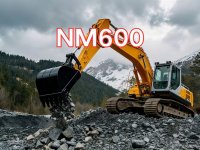

NM600
NM600 is an ultra-premium, ultra-high-strength wear-resistant steel plate, representing the highest hardness level currently available in industrially produced wear-resistant steels. Its designation follows the internationally recognized naming system for wear-resistant steels and primarily complies with the Chinese national standard GB/T 24186-2019 "High-Strength Wear-Resistant Steel Plates for Construction Machinery". This standard clearly specifies the grades, chemical composition, mechanical properties, hardness ranges, and testing methods for NM-series steels, serving as the core technical basis for production, inspection, and trade in both the Chinese and international markets. Compared to NM500 and NM550, NM600 further enhances hardness and wear resistance, specifically engineered for the most extreme and severe wear conditions globally. It is classified as a high-end specialty steel.
The designation "NM600" has the following meaning:
"NM" stands for "Nai Mo", the pinyin abbreviation of the Chinese term for "Wear-Resistant". This naming convention originated in the Chinese standard system and has become widely recognized globally as an identifier for high-strength low-alloy wear-resistant steels, distinguishing them from ordinary structural steels.
"600" indicates the average Brinell hardness of the steel after quenching and tempering heat treatment is 600 HBW. According to GB/T 24186-2019, its actual hardness typically ranges from 570 to 630 HBW. This is the highest grade defined within the current standard system, capable of withstanding the most intense abrasive wear, high-stress impact wear, and gouging wear. It represents the pinnacle of material wear resistance and is primarily used in critical components where service life and operational efficiency are paramount.
The primary application of NM600 steel plate is in manufacturing core wear components operating under the most extreme and harsh conditions, particularly in applications where ordinary steel and conventional wear-resistant steels fail to meet service life requirements. Typical applications include:
Mining and Quarry Equipment: Core wear parts in crushers, screens, and feeders that directly contact high-hardness ores and rock, such as jaw plates, liners, impact plates, and screens, maintaining exceptionally long service life under continuous high-intensity impact and grinding.
Construction Machinery: Bucket teeth, cutting edges, and base plates of large excavators and loaders—areas subjected to extreme wear, significantly extending equipment uptime in harsh conditions.
Dump Trucks and Haulage Vehicles: Floor and side panels of heavy-duty mining trucks and dumpers transporting highly abrasive materials like iron ore, basalt, and construction demolition debris, effectively preventing premature perforation and deformation.
Cement and Building Materials Industry: Critical components such as rollers, tables, and classifier vanes in vertical mills and roller presses, resisting continuous erosion from high-speed clinker and raw materials.
Power and Metallurgical Industries: Coal chutes, sinter plant hoppers, and blast furnace bins—areas prone to severe wear.
Its main characteristics include:
Ultimate Surface Hardness and Exceptional Wear Resistance: A hardness of 600 HBW provides unparalleled resistance to abrasive wear, offering a service life far exceeding that of ordinary steel and conventional wear-resistant steels, greatly reducing maintenance frequency and costs.
Optimized Toughness Matching: Despite its extreme hardness, NM600 achieves relatively better toughness among ultra-high-hardness steels through advanced microalloying and precise heat treatment, enabling it to withstand certain levels of impact loading.
Extremely High Welding Difficulty: Weldability is very poor and must strictly follow specialized welding procedures, including high-temperature preheating (typically ≥250°C), use of dedicated wear-resistant filler materials, strict control of interpass temperature, and post-weld insulation and slow cooling to prevent cracking.
Virtually No Cold Formability: It has no cold forming capability and can only be processed by cutting and drilling.
High Cost-Effectiveness (in Specific Applications): Although the material cost is very high, in extreme wear environments, the significant reduction in downtime and replacement costs due to its exceptionally long service life results in substantial overall economic benefits.
Therefore, NM600 is one of the highest-grade wear-resistant steels available for industrial applications and represents the ultimate solution for the most severe wear challenges.

Ultrasonic Testing (UT)
A key non-destructive testing technique that uses high-frequency sound waves to detect internal flaws in steel plates. The probe emits sound waves, which reflect when encountering defects such as cracks or inclusions. The receiver captures the echoes, enabling precise determination of defect location and size. With high sensitivity, strong penetration, and fast inspection speed, UT effectively ensures internal quality, widely used in the production of heavy plates, pressure vessel plates, and other high-end products to guarantee safety and reliability.

Magnetic Particle Testing (MT)
A common surface inspection method that magnetizes the workpiece, causing leakage magnetic fields at surface or near-surface defects like cracks or inclusions, which attract magnetic particles to form visible indications. Simple to operate and highly sensitive, MT is suitable for rapid inspection of surface and near-surface flaws in ferromagnetic materials, widely used for online or offline inspection of plate edges, ends, and welds, ensuring product quality and safety.

Penetrant Testing (PT)
A non-destructive method for detecting surface-breaking flaws. A penetrant liquid is applied to the cleaned steel surface, allowing it to seep into defects such as cracks or pores. After removing excess penetrant, a developer is applied, causing the trapped penetrant to bleed out and form visible indications. Simple and cost-effective, PT is suitable for inspecting surface defects in various non-porous materials, commonly used for welds, castings, and complex components, effectively ensuring surface quality of steel plates.








